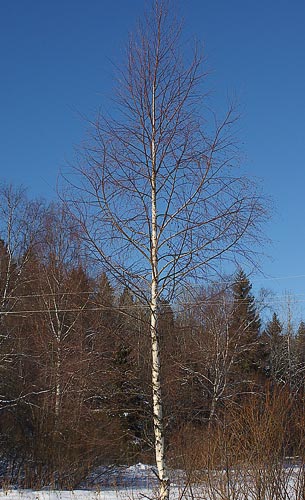Relatives
Betula pubescens Ehrh. - Downy birch, white birch.
Taxonomic position.
Family Betulaceae S.F.Gray, genus Betula L.Synonyms.
Betula alba L. nom. ambig., B. andreji V.Vassil., B. concinna Gunnarss., B. callosa Noto, B. ircutensis Sukacz., B. jacutica V.Vassil., B. kusmisscheffii (Regel) Sukacz., B. tortuosa Ledeb.Morphology and biology.
Deciduous tree up to 20 m tall. The height is different depending on habitat conditions. The trees reach maximum height in well drained soils, while in boggy areas 3-4 m. Trunk bark white (less often in mountains it may be yellowish or greyish) smooth or slightly fissured. Young shoots pubescent in various degrees, without glands. Leaves ovate or rhomboid-ovate, rounded at the base and acuminate at the apex, glabrous to pubescent at both surfaces, more often soft young ones are downy. Monoecious plant with unisexual flowers aggregated in catkins. Female (pistillate) catkins solitary, oblong, erect or slightly deflected. Floral scales with lateral lobes deflexed aside, glabrous, ciliate or pubescent above. Fruit is a winged nutlet, its wings 1.5-2.5 times as wide as the nutlet. It is characterized by a high polymorphism.Anemophilous. Anemochore. Propagates by seeds. Seeds are best planted in autumn or early spring. When planting in spring, the seeds are desirable to stratify for 1-2 months at 1-5 centigrades.
Flowers in May, mature fruits in late August - September. 2n=56.
Distribution.
Europe; European part of Russia (except for the northernmost and southern areas); throughout Siberia (except for the northernmost areas and arid steppified areas of Southwest Siberia); Northern Kazakhstan. The northern border of distribution range coincides with the limit of forest-tundra and tundra.Ecology.
Mesophyte. Photophilous. Distributed in the zone of coniferous and mixed forests almost everywhere as an additive secondary tree; appears as a pioneer plant on fire-sites and felled sites. In the zones of broad-leaved forests, forest-steppe and steppe prefers enclosed depressions and steppe cavities. May form primary associations in boggy habitats. Reaches the highest altitude of 2100 m in mountains of Altai and Sayan.Use and economic value.
Technical, medicinal, ornamental. Provides valuable carpentry and building timber, used for plywood production. Used in officinal and folk medicine. It is widely used in planting inhabited areas.References:
Gubanov IA., Kiseleva KV., Novikov VS., Tikhomirov VN. 2003. Illustrated Manual of the Middle Russia Plants. V.2. Moscow: KMK. 665 p. (In Russian).Koropachinskiy IYu., Vstovskaya TN. 2002. Woody plants of the Asian part of Russia. Novosibirsk: Publishing House of Siberian Division of the Russian Academy of Science, Branch "Geo". P.197-199. (In Russian).
Sokolov SI., Svjaseva OA., Kubli VA. 1977. Ranges of trees and shrubs of the USSR. V.1. Leningrad: Nauka. P.97-99. (In Russian).


